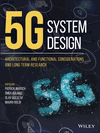Channel Modeling
Summary
The emerging 5th generation (5G) cellular systems raise unprecedented requirements on data rates, link reliabilities, end-to-end (E2E) latencies, and the support of a portfolio of different scenarios and service types. To satisfy 5G requirements, cutting-edge technology components are proposed both in academia and in industry. The design and evaluation of these technology components demand an accurate and efficient channel model. The most widely used channel model family is the well-known 3rd Generation Partnership Project (3GPP), spatial channel model (SCM) and Wireless World Initiative New Radio phase II (WINNER II) family, which follows the geometry-based stochastic channel model (GSCM) approach. This chapter describes core features of new channel models, such as path loss model, line-of-sight (LOS) probability modeling, outdoor-to-indoor (O2I) penetration loss modeling, and fast fading modeling. It also introduces additional features of new channel models, such as the modeling of large antenna arrays, blockage, scattering, and so on.
References
- 3GPP TR 36.873, “ Study on 3D channel model for LTE”, V12.4.0, March 2017
- FP7 METIS project, Deliverable D1.4, “ METIS channel models”, Febr. 2015
- 3GPP TR 38.901, “ Study on channel model for frequencies from 0.5 to 100 GHz”, V14.2.0, Sept. 2017
- ITU-R 5D/610-E, “ Updated combined proposal on IMT-2020 channel model”, June 2017
- 5G PPP mmMAGIC project, Deliverable D2.2, “ Measurement results and final channel models for preferred suitable frequency ranges”, May 2017
- Aalto University et al., “ 5G channel model for bands up to 100 GHz ”, Rev. 2.3, Oct. 2016
- S. Sun et al., “ Propagation path loss models for 5G urban micro- and macro-cellular scenarios”, IEEE Vehicular Technology Conference (VTC Spring 2016), May 2016
- ITU-R P1411-8, “ Propagation data and prediction methods for the planning of short-range outdoor radiocommunication systems and radio local area networks in the frequency range 300 MHz to 100 GHz”, July 2015
- K. Haneda, N. Omaki, T. Imai, L. Raschkowski, M. Peter and A. Roivainen, “Frequency-agile pathloss models for urban street canyons”, IEEE Transactions on Antennas and Propagation, vol. 64, no. 5, pp. 1941–1951, May 2016
- T. Bai, R. Vaze and R. W. Heath, “Analysis of blockage effects on urban cellular networks”, IEEE Transactions on Wireless Communications, vol. 13, no. 9, pp. 5070–5083, Sept. 2014
- T. Bai and R. W. Heath, “ Coverage in dense millimeter wave cellular networks”, Asilomar Conference on Signals, Systems and Computers, Nov. 2013
-
J. Jarvelainen, S. L. H. Nguyen, K. Haneda, R. Naderpour, and U. T. Virk, “Evaluation of millimeter-wave line-of-sight probability with point cloud data”, IEEE Wireless Communications Letters, vol. 5, no. 3, pp. 228–231, June 2016
10.1109/LWC.2016.2521656 Google Scholar
- ITU-R P.2040-1, “ Effects of building materials and structures on radiowave propagation above about 100 MHz”, July 2015
-
R. Verdone and A. Zanella, “ Pervasive Mobile and Ambient Wireless Communications: COST Action 2100”, Springer, 2012
10.1007/978-1-4471-2315-6 Google Scholar
- J. Medbo et al., “Radio propagation modeling for 5G mobile and wireless communications”, IEEE Communications Magazine, vol. 54, no. 6, pp. 144–151, June 2016
- P. Okvist, N. Seifi, B. Halvarsson, A. Simonsson, M. Thurfjell, H. Asplund and J. Medbo, “ 15 GHz street-level blocking characteristics assessed with 5G radio access prototype”, IEEE Vehicular Technology Conference (VTC Spring 2016), May 2016
- P. Beckmann and A. Spizzichino, “ The Scattering of Electromagnetic Waves from Rough Surfaces”, Artech House, 1987
- D. Dupleich et al., “ Directional characterization of the 60 GHz indoor-office channel”, URSI General Assembly and Scientific Symposium (URSI GASS 2014), Aug. 2014
- X. Cheng, C. -X. Wang, D. Laurenson, S. Salous and A. Vasilakos, “An adaptive geometry-based stochastic model for non-isotropic MIMO mobile-to-mobile channels”, IEEE Transactions on Wireless Communications, vol. 8, no. 9, pp. 4824–4835, Sep. 2009
- Y. Yuan, C.-X. Wang, X. Cheng, B. Ai and D. Laurenson, “Novel 3D geometry-based stochastic models for non-isotropic MIMO vehicle-to-vehicle channels”, IEEE Transactions on Wireless Communications, vol. 13, no. 1, pp. 298–309, Jan. 2014
- J. Karedal, F. Tufvesson, N. Czink, A. Paier, C. Dumard, T. Zemen, C. F. Mecklenbräuker, and A. F. Molisch, “A geometry-based stochastic MIMO model for vehicle-to-vehicle communications”, IEEE Transactions on Wireless Communications, vol. 8, no. 7, pp. 3646–3657, July 2009
- A. Kato, K. Sato, M. Fujise and S. Kawakami, “Propagation characteristics of 60-GHz millimeter waves for ITS inter-vehicle communications”, IEICE Transactions on Communications, vol. E84-B, no. 9, pp. 2530–2539, Sep. 2001
- E. Ben-Dor, T. S. Rappaport, Y. Qiao, and S. J. Lauffenburger, “ Millimeter-wave 60 GHz outdoor and vehicle AOA propagation measurements using a broadband sounder”, IEEE Global Communications Conference (GLOBECOM 2011), Dec. 2011
- A. Yamamoto, K. Ogawa, T. Horimatsu, A. Kato and M. Fujise, “Path-loss prediction models for intervehicle communication at 60 GHz”, IEEE Transactions on Vehicular Technology, vol. 57, no. 1, pp. 65–78, Jan. 2008
- M. G. Sánchez, M. P. Táboas and E. L. Cid, “Millimeter wave radio channel characterization for 5G vehicle-to-vehicle communications”, Measurement, vol. 95, pp. 223–229, Jan. 2017
- ITU-R P.676-11, “ Attenuation by atmospheric gases”, Sep. 2016
- S. Wu, C. -X. Wang, el-H. M. Aggoune, M. M. Alwakeel and Y. He, “A non-stationary 3-D wideband twin-cluster model for 5G massive MIMO channels”, IEEE Journal on Selected Areas in Communications, vol. 32, no. 6, pp. 1207–1218, June 2014
- S. Payami and F. Tufvesson, “ Channel measurements and analysis for very large array systems at 2.6GHz”, European Conference on Antennas and Propagation (ECAP 2012), Mar. 2012
- K. Haneda, J. Järveläinen, A. Karttunen, M. Kyro and J. Putkonen, “A statistical spatio-temporal radio channel model for large indoor environments at 60 and 70 GHz”, IEEE Transactions on Antennas and Propagation, vol. 63, no. 6, pp. 2694–2704, June 2015
- A. F. Molisch, F. Tufvesson, J. Karedal and C. F. Mecklenbrauker, “A survey on vehicle-to-vehicle propagation channels”, IEEE Wireless Communications, vol. 16, no. 6, pp. 12–22, Dec. 2009



